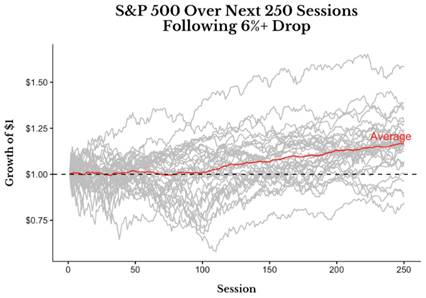
Has the Market Caught the Corona Virus?
Has the Market Caught the Corona Virus?
With news of the corona virus spreading outside of China, US markets (S&P 500) dropped more than 6% over Monday and Tuesday’s trading sessions, and erased more than $1.7 trillion of its value. This marks the largest 2-day drop since the flash crash of August 2015, and is the catalyst behind this update to our 2019 Investment Fire Drill note.
Fire drills are an important safety precaution because they offer a practice run for an unpredictable event. During a fire, when emotions are high and rational thinking is in short supply, having a defined process in place increases the probability of generating the best and safest possible outcome.
Similarly, market downturns are unpredictable. However, we can help prepare ourselves to respond appropriately during periods of increased market turmoil. By examining historical similarities and having a well-defined plan in place, we gain a better understanding of what our response should be and how we can benefit from market volatility.
Since 1950 there have been 34 instances where the S&P 500 was down by 6% or more over a two-day trading session. Considering there are 17,655 two-day trading session over this time frame, we have only seen trading activity of this sort on 0.2% of all trading days, or once every 2 years on average. It’s easy to look through the rear-view mirror and generate headlines as to what triggered the unusual selling, but the important question is what happens next?
The chart below illustrates that after a 6%+ drop over two days, the S&P 500 was up an average of 16.7% over the next 12-month period (~250 trading days).

Source: YCharts, 1950 – 2020
More importantly, of the 34 instances shown above, only 4 had failed to register a positive return 1 year after the large two-day decline.
We can anticipate market weakness, but it is impossible to time a market pullback correctly. The last three months of 2018 was the worst quarter for stocks in seven years. The first three months of 2019 was the best quarter for stocks in 10 years. Even if you did get out at the right time, then you would need to accurately time the beginning of the recovery as well. History shows that this is impossible. Markets are overwhelmingly positive over time and equity market investments are required to build wealth, responsibly, over time.
It’s worth revisiting the 5 strategies outlined by CI Investments to help you respond to difficult markets:
It’s worth revisiting the 5 strategies outlined by CI Investments to help you respond to difficult markets:
- Take a long-term view,
- Be diversified,
- Resist the temptation of market timing,
- Take advantage of market volatility,
- Work with an advisor.
The market, for some time, will likely by subject to wide swings based on the news of the moment. But in every case of panic, as the table below illustrates, the market has recovered.

We do not expect it to be any different this time. Volatility is a constant and we have absolutely no control over what the market does. What we can and need to control is how we react to it.
We think the best approach is to make sure that your short-term goals and income requirements are met with investments that provide stability in market volatility, or have no market volatility at all. Those are goals with a 3 – 5 year time-frame. They could include retirement income, buying a car, or paying for education. Your longer-term goals will be met by establishing a diversified asset allocation strategy that matches your risk profile and time horizon. This strategy provides you with the opportunity to earn the long-term returns needed to reach your goals.
Late in an economic growth cycle (like we are currently in), we may tilt a portfolio slightly to provide some additional capital protection in order to provide some liquidity to rebalance during the market pullback. This provides you with the opportunity to add growth at a time when there is much less market risk. Our experience and research suggest that small moves away from your target asset allocation is all that is required to provide a boost to your longer-term portfolio performance.
In the world of investing, nothing lasts forever. Both market up swings and market corrections. The only thing we can be certain of is that ups and downs will continue, and that both economies and successful companies expand over long periods time. And if history is any guide, investors that manage to stay invested over long periods of time will find their portfolios expand as well.
We are here to answer your questions, and encourage you to call if you have concerns.
